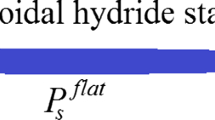Abstract
With regard to the quantitative modelling of delayed hydride cracking (DHC), it has been shown in Part I [9] that when a lenticular shaped hydrided region, i.e. one whose length is large compared with its thickness, forms at a planar surface or at the surface of a very blunt notch, the compressive stress σH induced within the region is markedly influenced by the unconstrained transverse precipitation strains as well as the unconstrained normal strain. The σH values are approximately the same irrespective of whether we assume that (a) the overall unconstrained expansion strain associated with hydride precipitation is confined entirely to the normal direction or (b) the strain is partitioned approximately equally between the three orthogonal directions. Thus, assuming the strain to be entirely in the normal direction allows for both precipitation strain scenarios.
The paper extends the considerations in Part I to the case where there is a hydrided region immediately ahead of a sharp crack, i.e. the other extreme to that considered in the earlier work, a model situation that simulates the behaviour of a growing DHC crack. In this case the normal stress within the region immediately ahead of the crack tip is not compressive but tensile, and is influenced by the unconstrained transverse precipitation strains, though not to the same extent as is the hydride induced stress associated with a hydrided region that emanates from a planar surface. Assuming the strain to be entirely in the normal direction overestimates the local stresses, and therefore unlike the planar surface situation, the assumption does not allow for both precipitation strain scenarios. It is therefore important to input the correct unconstrained precipitation strain tensor, if we require a reasonably accurate quantitative picture of DHC crack growth.
Similar content being viewed by others
References
G. C. Weatherly, Acta Metall. 29 (1981) 501.
E. Smith, I. J. Press. Vess. Piping 60 (1994) 159.
Idem., ibid. 61 (1995) 1.
Idem., J. Mater. Sci. 29 (1994) 1121.
Idem., Int. J. Press. Vess. Piping 62 (1995) 9.
G. J. C. Carpenter, J. Nucl. Mater 48 (1973) 264.
S. Q. Shi and M. P. Puls, ibid. 208 (1994) 232.
S. Q. Shi, M. P. Puls and S. Sagat, ibid. 208 (1994) 243.
E. Smith, J. Mater. Sci. 32 (1997) 1121.
J. Weertman and J. R. Weertman, “Elementary dislocation theory”, Macmillan Series in Materials Sciences (Macmillan, New York, 1967).
H. Tada, P. C. Paris and G. R. Irwin, “The stress analysis of cracks handbook”, (Del Research Corporation, Hellertown, PA, 1973).
L. R. F. Rose, J. Mech. Phys. Solids 34 (1986) 609.
Author information
Authors and Affiliations
Rights and permissions
About this article
Cite this article
SMITH, E. The stress in a zirconium alloy due to the hydride precipitation misfit strains: Part II Hydrided region at a crack tip. Journal of Materials Science 32, 1127–1131 (1997). https://doi.org/10.1023/A:1018563313837
Published:
Issue Date:
DOI: https://doi.org/10.1023/A:1018563313837




